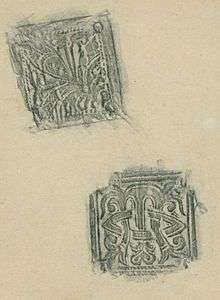Rubbing
.jpg)
A rubbing of portions of a book cover

Rubbing of Icelandic woodcuts
A rubbing (frottage) is a reproduction of the texture of a surface created by placing a piece of paper or similar material over the subject and then rubbing the paper with something to deposit marks, most commonly charcoal or pencil, but also various forms of blotted and rolled ink, chalk, wax, and many other substances. For all its simplicity, the technique can be used to produce blur-free images of minuscule elevations and depressions on areas of any size in a way that can hardly be matched by even the most elaborate, state-of-the-art methods. In this way, surface elevations measuring only a few thousandths of a millimeter can be made visible.[1]
Common uses for this technique include:
- Brass rubbing, to make copies of monumental brasses
- Forensic uses, including finding out what was written on a sheet of paper removed from a pad by rubbing the impressions left on subsequent sheets or other backing materials
- Frottage, a surrealist art form
- Stone rubbing, to make copies of patterns and inscriptions of gravestones or other incised or textured stone surfaces
References
External links
| Wikimedia Commons has media related to Rubbings or tripsigraphs. |
This article is issued from
Wikipedia.
The text is licensed under Creative Commons - Attribution - Sharealike.
Additional terms may apply for the media files.